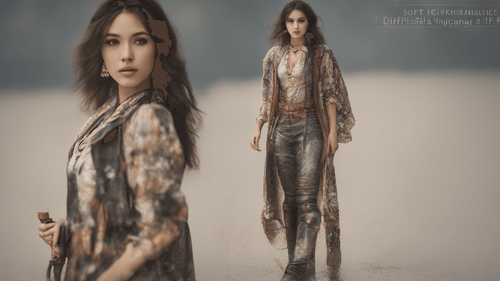
Introduction
Artificial Intelligence (AI) has been making remarkable strides in various fields, and one of the most intriguing applications is in generating images. The marriage of AI and image generation has given birth to an entirely new realm of creative possibilities. In this article, we delve into the fascinating world of AI image generation, exploring its significance, capabilities, and the impact it has on different industries.
AI Image Generated: Redefining Visual Creativity
In the rapidly evolving landscape of technology, AI image generation has emerged as a game-changer. With algorithms that can mimic human creativity and style, AI-generated images are becoming increasingly indistinguishable from those crafted by human hands. This phenomenon raises questions about the essence of creativity and challenges conventional perceptions of artistry.
The Intersection of Art and Algorithms
At the heart of AI image generation lies a complex interplay between artistic sensibilities and intricate algorithms. These algorithms analyze vast datasets to learn patterns, styles, and aesthetics, enabling them to produce images that align with human preferences. This amalgamation of art and algorithms opens up a realm of possibilities that artists and creators are only beginning to explore.
From Pixels to Masterpieces: How AI Generates Images
AI-powered image generation involves feeding large datasets of images into neural networks. These networks, particularly Generative Adversarial Networks (GANs), consist of two parts: the generator and the discriminator. The generator creates images, while the discriminator assesses them for authenticity. Through a continuous feedback loop, GANs improve their ability to generate high-quality images that often blur the line between reality and simulation.
Advantages of AI-Generated Images
AI image generation offers numerous advantages that are transforming industries and creative endeavors:
-
Infinite Creativity: AI-generated images can produce an infinite variety of styles, making it a powerful tool for artists seeking inspiration.
-
Efficiency: AI can rapidly create images, saving time and resources for designers and content creators.
-
Exploration of Styles: Artists can experiment with diverse styles without manual mastery, broadening their creative horizons.
-
Personalization: AI-generated images can be tailored to individual preferences, enhancing user experiences in various applications.
AI Image Generation in Various Industries
The impact of AI-generated images is resonating across diverse sectors, revolutionizing how professionals approach creativity and design.
Fashion and Design: Dressing Up with AI
In the fashion industry, AI-generated images are altering the way designers conceptualize and create apparel. Designers can now visualize different fabrics, patterns, and color combinations with unprecedented speed. AI also aids in predicting fashion trends by analyzing consumer preferences and historical data, providing insights that drive innovative designs.
Gaming and Entertainment: Crafting Immersive Realities
The gaming and entertainment sectors have embraced AI-generated images to create lifelike characters, breathtaking landscapes, and immersive virtual worlds. Through procedural generation, AI algorithms can produce vast gaming environments, ensuring that players encounter novel experiences with every playthrough.
Advertising and Marketing: A Visual Revolution
In the realm of advertising, AI-generated images are reshaping how brands communicate with their audiences. Marketers can create personalized, attention-grabbing visuals that resonate with consumers on a deeper level. This newfound ability to tailor images to specific demographics enhances engagement and brand loyalty.
Medical Imaging: Precision and Innovation
Even in the medical field, AI-generated images are playing a pivotal role. Medical imaging, such as MRI and CT scans, benefits from AI algorithms that enhance image quality and aid in diagnostics. AI's ability to generate synthetic medical images is aiding research and training for medical professionals.
Challenges and Ethical Considerations
While AI-generated images offer remarkable benefits, they also present a set of challenges and ethical considerations that demand careful consideration.
Intellectual Property Concerns
Determining ownership and copyright of AI-generated images raises complex legal questions. As algorithms blend styles and influences, defining the original creator becomes a challenge.
Bias and Representation
AI algorithms learn from existing datasets, which can perpetuate biases present in the data. This raises concerns about the accurate representation of diverse communities in AI-generated images.
Dehumanizing Creativity?
The rise of AI-generated images prompts discussions about the authenticity of creativity. Can machines truly replicate the depth of human artistic expression, or are they merely imitating patterns learned from data?
FAQs
How does AI generate images?
AI generates images using neural networks, particularly Generative Adversarial Networks (GANs), which consist of a generator and a discriminator. GANs improve their image generation abilities through continuous feedback.
Can AI-generated images replace human creativity?
AI-generated images are a tool that complements human creativity rather than replacing it. They offer new avenues for exploration and inspiration.
Are AI-generated images legally protected?
The legal status of AI-generated images is complex. Determining copyright and ownership can be challenging due to the algorithmic nature of creation.
Do AI-generated images have artistic value?
AI-generated images are increasingly recognized for their artistic value. They challenge traditional notions of artistry and open discussions about creativity's essence.
How do AI-generated images impact industries?
AI-generated images are transforming industries like fashion, gaming, advertising, and medicine by offering efficiency, personalization, and innovation.
What are the ethical concerns related to AI image generation?
Ethical concerns include bias in training data, issues of authenticity, and potential implications for the future of human creativity.
Conclusion
AI image generation represents a seismic shift in how we perceive and create visual content. As algorithms and creativity converge, new frontiers of imagination are being explored. While challenges persist, the symbiotic relationship between AI and human creativity promises a future where artistry knows no bounds. The journey of AI-generated images is a testament to the boundless possibilities that technology continues to unfold.
(Note: This article is for informational purposes only and does not constitute legal, professional, or expert advice. The views and opinions expressed are solely those of the author.)